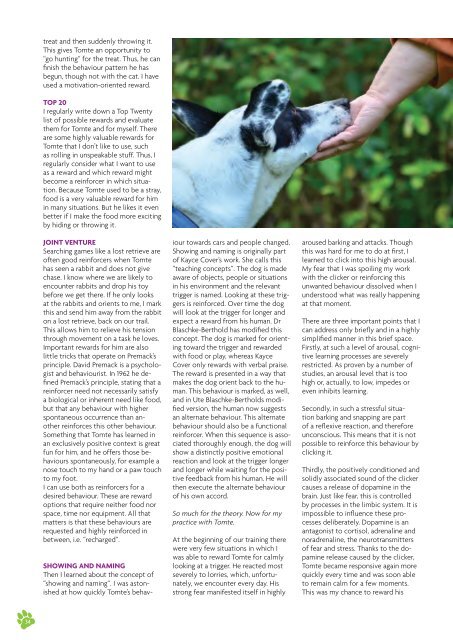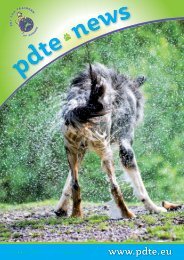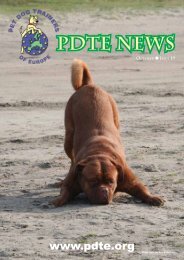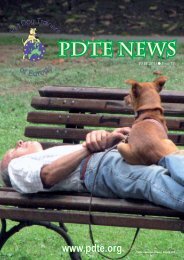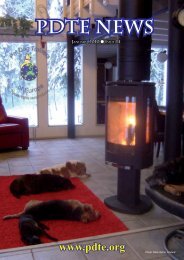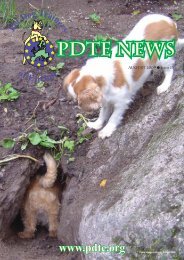PDTE 2013 Winter Newsletter
Create successful ePaper yourself
Turn your PDF publications into a flip-book with our unique Google optimized e-Paper software.
treat and then suddenly throwing it.<br />
This gives Tomte an opportunity to<br />
“go hunting“ for the treat. Thus, he can<br />
finish the behaviour pattern he has<br />
begun, though not with the cat. I have<br />
used a motivation-oriented reward.<br />
TOP 20<br />
I regularly write down a Top Twenty<br />
list of possible rewards and evaluate<br />
them for Tomte and for myself. There<br />
are some highly valuable rewards for<br />
Tomte that I don’t like to use, such<br />
as rolling in unspeakable stuff. Thus, I<br />
regularly consider what I want to use<br />
as a reward and which reward might<br />
become a reinforcer in which situation.<br />
Because Tomte used to be a stray,<br />
food is a very valuable reward for him<br />
in many situations. But he likes it even<br />
better if I make the food more exciting<br />
by hiding or throwing it.<br />
JOINT VENTURE<br />
Searching games like a lost retrieve are<br />
often good reinforcers when Tomte<br />
has seen a rabbit and does not give<br />
chase. I know where we are likely to<br />
encounter rabbits and drop his toy<br />
before we get there. If he only looks<br />
at the rabbits and orients to me, I mark<br />
this and send him away from the rabbit<br />
on a lost retrieve, back on our trail.<br />
This allows him to relieve his tension<br />
through movement on a task he loves.<br />
Important rewards for him are also<br />
little tricks that operate on Premack’s<br />
principle. David Premack is a psychologist<br />
and behaviourist. In 1962 he defined<br />
Premack’s principle, stating that a<br />
reinforcer need not necessarily satisfy<br />
a biological or inherent need like food,<br />
but that any behaviour with higher<br />
spontaneous occurrence than another<br />
reinforces this other behaviour.<br />
Something that Tomte has learned in<br />
an exclusively positive context is great<br />
fun for him, and he offers those behaviours<br />
spontaneously, for example a<br />
nose touch to my hand or a paw touch<br />
to my foot.<br />
I can use both as reinforcers for a<br />
desired behaviour. These are reward<br />
options that require neither food nor<br />
space, time nor equipment. All that<br />
matters is that these behaviours are<br />
requested and highly reinforced in<br />
between, i.e. “recharged“.<br />
SHOWING AND NAMING<br />
Then I learned about the concept of<br />
“showing and naming“. I was astonished<br />
at how quickly Tomte’s behaviour<br />
towards cars and people changed.<br />
Showing and naming is originally part<br />
of Kayce Cover’s work. She calls this<br />
“teaching concepts“. The dog is made<br />
aware of objects, people or situations<br />
in his environment and the relevant<br />
trigger is named. Looking at these triggers<br />
is reinforced. Over time the dog<br />
will look at the trigger for longer and<br />
expect a reward from his human. Dr<br />
Blaschke-Berthold has modified this<br />
concept. The dog is marked for orienting<br />
toward the trigger and rewarded<br />
with food or play, whereas Kayce<br />
Cover only rewards with verbal praise.<br />
The reward is presented in a way that<br />
makes the dog orient back to the human.<br />
This behaviour is marked, as well,<br />
and in Ute Blaschke-Bertholds modified<br />
version, the human now suggests<br />
an alternate behaviour. This alternate<br />
behaviour should also be a functional<br />
reinforcer. When this sequence is associated<br />
thoroughly enough, the dog will<br />
show a distinctly positive emotional<br />
reaction and look at the trigger longer<br />
and longer while waiting for the positive<br />
feedback from his human. He will<br />
then execute the alternate behaviour<br />
of his own accord.<br />
So much for the theory. Now for my<br />
practice with Tomte.<br />
At the beginning of our training there<br />
were very few situations in which I<br />
was able to reward Tomte for calmly<br />
looking at a trigger. He reacted most<br />
severely to lorries, which, unfortunately,<br />
we encounter every day. His<br />
strong fear manifested itself in highly<br />
aroused barking and attacks. Though<br />
this was hard for me to do at first, I<br />
learned to click into this high arousal.<br />
My fear that I was spoiling my work<br />
with the clicker or reinforcing this<br />
unwanted behaviour dissolved when I<br />
understood what was really happening<br />
at that moment.<br />
There are three important points that I<br />
can address only briefly and in a highly<br />
simplified manner in this brief space.<br />
Firstly, at such a level of arousal, cognitive<br />
learning processes are severely<br />
restricted. As proven by a number of<br />
studies, an arousal level that is too<br />
high or, actually, to low, impedes or<br />
even inhibits learning.<br />
Secondly, in such a stressful situation<br />
barking and snapping are part<br />
of a reflexive reaction, and therefore<br />
unconscious. This means that it is not<br />
possible to reinforce this behaviour by<br />
clicking it.<br />
Thirdly, the positively conditioned and<br />
solidly associated sound of the clicker<br />
causes a release of dopamine in the<br />
brain. Just like fear, this is controlled<br />
by processes in the limbic system. It is<br />
impossible to influence these processes<br />
deliberately. Dopamine is an<br />
antagonist to cortisol, adrenaline and<br />
noradrenaline, the neurotransmitters<br />
of fear and stress. Thanks to the dopamine<br />
release caused by the clicker,<br />
Tomte became responsive again more<br />
quickly every time and was soon able<br />
to remain calm for a few moments.<br />
This was my chance to reward his<br />
34


